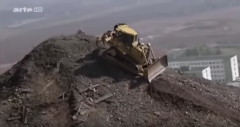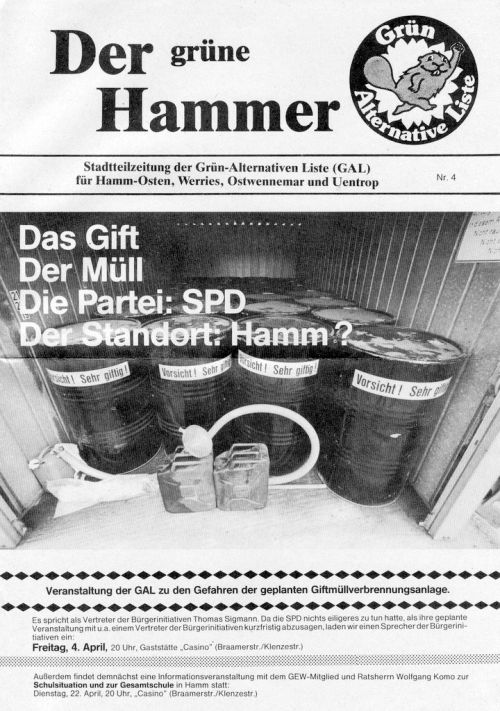Newsletter X 2021 | |
March 03th to 09st
***
| 2024 | 2023 | 2022 | 2021 | |
| 2020 | 2019 | 2018 | 2017 | 2016 |
| 2015 | 2014 | 2013 | 2012 | 2011 |
| Current news+ | Background knowledge |
***
March 09, 2021 - Nuclear phase-out: carelessness pays off
*
March 08, 2021 - Japan's nuclear white elephant
*
March 08, 2021 - Compensation for the nuclear phase-out: Criticism at the wrong address
*
March 08, 2021 - Nuclear Authority approves new reactors at Dukovany NPP
*
Neckarwestheim nuclear power plant
March 08, 2021 - Almost 500 nuclear opponents on the road
*
Japan should focus on green energy
March 07, 2021 - Majority of Fukushima disaster survivors support phasing out nuclear energy
*
March 07, 2021 - CSU against transport of nuclear waste to Grafenrheinfeld
*
March 07, 2021 - Planning for the Würgassen nuclear storage facility continues
*
March 06, 2021 - Protest at the Brandenburg Gate: Remembrance of Fukushima
*
March 05, 2021 - Preparations for nuclear armament begin in Germany
*
March 05, 2021 - Nuclear phase-out: Government and energy companies agree on damages
*
March 05, 2021 - nuclear stop: 'In the future without EURATOM' officially registered as a petition in the European Parliament
The successful registration of the petition 'In the future without EURATOM' can announce an atomic stop - on the very same day on which a timetable for the several times postponed start of the 'Conference on the Future of Europe' was fixed.
»It is a good day for the important further development of the European idea: the long postponed 'Conference on the Future of Europe' will now start on Europe Day, May 9th! In this context, the citizens of the EU are expressly invited to express their concerns to politicians. And the first hundreds of supporters ofIn the future without EURATOM'are already there in time, because our petition has now been confirmed with the official registration by the EU Parliament! «...
*
March 05, 2021 - Ten years of the Fukushima nuclear disaster: Never again!
*
March 04, 2021 - Rhineland-Palatinate wants to use parking spaces for solar power
*
March 04, 2021 - Leak or rupture? Expert demands that Neckarwestheim II be switched off
*
March 03, 2021 - No to Russia's participation in fuel element production in Lingen
*
A triple step in the right direction.
March 03, 2021 - More transparency for lobbyists: lobby register is coming
*
March 03, 2021 - EU Commission reviews billions in compensation for coal companies
*
Please also read the comments.
March 03, 2021 - Nuclear power plant rubble: Independent criticize trivialization
Top | |
| Current news+ | Background knowledge |
***
Current news+
**
March 03, 2021 - Radioactivity feeds deep biosphere
Radioactive decay provides microbes in the deep sediment with their livelihoods
Radiant food source: Much of the living environment in deep sediments is fueled by radioactivity - the natural decay of radioactive elements, a study has now confirmed. Because the radiation released in the process generates hydrogen and other molecules that are vital for the microbes. In wet sediment, a particularly large amount of radiation-induced hydrogen is produced - this could have consequences for nuclear repositories ...
Top | |
| Current news+ | Background knowledge |
***
Background knowledge
**
reaktorpleite.de
Map of the nuclear world:
Maybe we shouldn't bury our nuclear waste as deeply as possible,
but we should definitely leave the uranium in the ground ...
The German version of this world map:
https://www.google.com/maps/d/viewer?mid=1fCmKdqlqSCNPo3We1TWZexPjgNDQOaLD
**
The search in the reaktorpleite.de with the search term
| Radioactivity | ||
brought the following results, among others:
October 29, 2019 - Radioactive Glacial Dust - Cryoconite holds a radiant secret
**
YouTube channel "Reaktorpleite"
 Yellow Cake: The Clean Energy Lie
Yellow Cake: The Clean Energy Lie
**
AtomkraftwerkePlag
Radioactivity and radiation
What does "radioactive radiation" mean?
The radiation to which we are exposed comes from various sources: from space, from rocks and gases, from medicine, from nuclear weapon tests, as well as from nuclear accidents and the operation of nuclear power plants.
The term "radioactive radiation" used in everyday language actually covers two phenomena: radioactivity and ionizing radiation.
Radioactivity is understood to be the property of radionuclides (unstable atomic nuclei) to decay, ie to transform themselves spontaneously into other atomic nuclei. Radionuclides occur naturally, but can also be produced artificially during nuclear fission in nuclear power plants.
When unstable atomic nuclei decay, so-called ionizing radiation is emitted. Ionizing radiation occurs in different ways: as particle radiation, such as B. alpha radiation from protons and neutrons (α radiation) and beta or electron radiation from electrons (β radiation), and as electromagnetic radiation, such as. B. Gamma radiation (γ radiation). If ionizing radiation hits atoms or molecules, it can knock out electrons, leaving ions or molecular residues. In other words: it can change and destroy atoms and molecules of matter, including cells and tissues of living beings. Ionizing radiation can break the DNA strand and cause irreversible damage. Altered cell division, for example, can result in an altered blood count or cancer ...
*
Plutonium batteries and radioactive contamination
For decades, so-called radionuclide batteries have been used in space travel to generate electricity, which generate energy from radioactive decay; the English term for it is Radioisotope Thermoelectric Generators (RTGs). Plutonium or americium are mostly used in RTGs. In addition, so-called radioisotope heater units (RHUs) have been developed to generate heat for the instruments.
The US first used an RTG in 1961 on the Transit 4A navigation satellite, and another in 1969 on the Nimbus III weather satellite. RTGs and partly RHUs were used in the missions Apollo, Pioneer, Viking, Voyager, Galileo, Ulysses, Cassini and New Horizons. The Mars rovers Pathfinder, Spirit and Opportunity used solar energy, but generated the heat for the instruments with RHUs. During the Curiosity mission from 2011, the multi-mission radioisotope thermoelectric generator was used for the first time to generate electricity and heat. Since the 1960s, the Soviet Union and later Russia also used radionuclide batteries in space travel.
The use of radioactive batteries has led to serious accidents several times:
In 1964, a US Navy satellite crashed on launch, distributing one kilogram of plutonium into the atmosphere.
In 1978 the reactor core of the Soviet satellite "Kosmos 954" contaminated 124.000 square kilometers in Canada after a crash landing.
In 1996 the Russian Mars-96 probe crashed with 200 grams of plutonium into the border area between Chile and Bolivia ...
**
Wikipedia
Radioactivity in the environment
Radioactivity occurs partly naturally in our environment (without human intervention), partly it was or is generated by human activities (“anthropogenic”). The causes of natural radioactive radiation are primordial radionuclides with their secondary products as well as nuclides that are generated by cosmic radiation in the earth's atmosphere. Human-made radioactivity usually has an isotopic composition that differs from the natural one, because it also contains short-lived radionuclides that do not arise in series of decays or spallation processes.
Naturally occurring radioactivity
The primordial radionuclides come from the material of the primordial earth and are still present today because of their long half-life. These include potassium-40, which is always contained in the human body, and the isotopes of uranium, which are important as nuclear fuel. Other radionuclides arise indirectly as the decay products of the radioactive decay series of these primordial nuclides that are constantly being reproduced, such as the radon gas that escapes from all over the earth. These nuclides are called radiogenic. Further, cosmogenic radionuclides are continuously generated in the atmosphere through nuclear reactions with cosmic rays. They include carbon-14, which, like potassium-40, enters all organisms through the metabolism.
The radiation from the ubiquitous natural radionuclides is known as terrestrial radiation.
Radioactivity generated or released by humans
Long before radioactivity was discovered, human activities such as mining and burning coal had released radioactive substances. Paracelsus described Schneeberger disease in 1567. Metal ores and coal contain more radionuclides than the average biosphere; Mine systems transport radon from the interior of the earth to the surface.
With the mining of uranium, the construction of nuclear power plants, and most importantly the construction and above-ground testing of nuclear weapons, radioactivity was released into the biosphere, which had a global impact.
Large amounts of radioactive substances were released (in addition to the nuclear tests up to 1963) through accidents in nuclear facilities. Best known are the Chernobyl nuclear disaster and the Fukushima nuclear disaster. After 1990, the Kyshtym accident in 1957 and the Ostural Trail that emerged in the process became known ...
*
Radionuclide batteries for space travel
A sufficiently large, compactly arranged amount of 238Pu heats up to white heat due to its own radioactive decay and emits only very small amounts of gamma radiation, so that one gets by with the thinnest shielding compared to five other potentially suitable nuclides. It is therefore used in oxidized form as chemically inert plutonium dioxide to generate electrical energy in radionuclide batteries.
Because of their longevity, radionuclide batteries are used in interplanetary space travel, especially for space probes that are supposed to reach the outer solar system. Because solar cells no longer supply enough energy at a great distance from the sun. Such nuclear batteries were built into the Voyager probes, Cassini-Huygens (1997–2005 for Saturn) or New Horizons (2006–2015 for Pluto), for example. In the past, radionuclide batteries with plutonium 238Pu were also used in orbiting satellites.
In 1964, the US Transit 5BN-3 satellite with a radionuclide battery on board burned up in a false start about 50 kilometers above the Pacific. The satellite contained almost one kilogram of plutonium, which was then measurably distributed over the entire northern hemisphere ...
**
Further to: Newspaper article 2021
***
Top | |
| Current news+ | Background knowledge |
***
Donation appeal
- The THTR circular is published by the 'BI Environmental Protection Hamm' and is financed by donations.
- The THTR circular has meanwhile become a much-noticed information medium. However, there are ongoing costs due to the expansion of the website and the printing of additional information sheets.
- The THTR circular researches and reports in detail. In order for us to be able to do that, we depend on donations. We are happy about every donation!
Donations account:
BI Umweltschutz Hamm
Purpose: THTR circular
IBAN: DE31 4105 0095 0000 0394 79
BIC: WELADED1HAM
***
***



